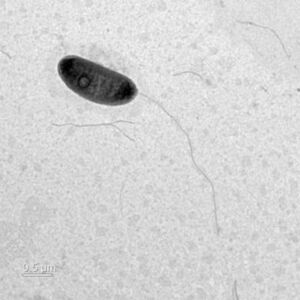Ochrobacterium teleogrylli: Difference between revisions
(→=) |
No edit summary |
||
| (22 intermediate revisions by the same user not shown) | |||
| Line 1: | Line 1: | ||
{{Uncurated}} | {{Uncurated}} | ||
[[Image: | [[Image:Ochrobacterium teleogrylli.jpg|thumb|300px|right|Transmission electron photomicrograph of a single flagellated Ochrobactrum soli sp., Isolated from a Korean Cattle Farm. Image credit: Gyu-Min Choi, Hankyong National University | ||
https://www.researchgate.net/publication/338707697_Ochrobactrum_soli_sp_nov_Isolated_from_a_Korean_Cattle_Farm | |||
(due to lack of images of the teleogrylli species, I have chosen an image of a Ochrobacterium from the same genus)]] | |||
==Classification== | ==Classification== | ||
| Line 9: | Line 12: | ||
===Species=== | ===Species=== | ||
https://www.ncbi.nlm.nih.gov/data-hub/taxonomy/2479765/ | |||
Ochrobacterium teleogrylli | |||
Ochrobacterium teleogrylli | |||
==Description and Significance== | ==Description and Significance== | ||
Ochrobacterium teleogrylli can be plant and animals symbionts, usually this genus is known as opportunistic pathology, however this species is not. (Ryan, M. 2020) Other members of the genus Ochrobacterium are essential for insects such as hessian flies to service on plant seeds. Ochrobacterium teleogrylli is essential for the Teleogryllus Gryllidae crickets to survive in wastelands of China. (Hu, Mengyao et al. 2020) | |||
==Genome Structure== | ==Genome Structure== | ||
Cells are short rod-shaped and are 0.7–0.98×0.93–1.93μm in size. Its is 16S rRNA gene is MK063698.( Hu M, et. al 2020) | |||
Members of the Ochrobacterium have the ability to reduce nitrogen, however this species cannot. However Ochrobacterium Teleogrylli has the ability to hydrolyze gelatin. (Hu M, et. al 2020) | |||
==Cell Structure, Metabolism and Life Cycle== | ==Cell Structure, Metabolism and Life Cycle== | ||
Ochrobacterium teleogrylli is gram stain negative, non-spore forming, oxidase- positive, aerobic and motile by means of flagella. (Pembroke, T., 2020) | |||
This strain was isolated from the insect Teleogryllus occipitalis, a cricket found in croplands in China. (Hu M., et al, 2020.) There is not much information about the life cycle and metabolism of this bacterium but hopefully we see developments in research of this microbe. | |||
==Ecology and Pathogenesis== | ==Ecology and Pathogenesis== | ||
This bacterium is known for its ability to degrade pesticides in contaminated croplands. These pesticides include glyphosate, phoxim, chlorpyrifos, Ochrobacterium teleogrylli has been shown to effectively degrade these. (Hu M., et al, 2020) | |||
- found | Ochrobacterium teleogrylli bacterium is found in the insect Teleogryllus occipitalis which is typically found in the Shuangliu district of China. The bacterium were discovered by taking the crickets, crushing them up, and staining them. It is thought that Ochrobacterium teleogrylli and Teleogryllus occipitalis have a mutualistic relationship. The insecticide-degrading bacterium found on the organisms benefit them since it gives the crickets insecticide resistance. | ||
(Hu M., et al, 2020) | |||
<br><br> | <br><br> | ||
| Line 35: | Line 43: | ||
==References== | ==References== | ||
Hu, Mengyao et al. “Ochrobactrum teleogrylli sp. nov., a pesticide-degrading bacterium isolated from the insect Teleogryllus occipitalis living in deserted cropland.” International journal of systematic and evolutionary microbiology vol. 70,4 (2020): 2217-2225. doi:10.1099/ijsem.0.003964 | |||
https:// | Nikola Szpakowska, Agnieszka Kowalczyk, Sylwia Jafra, Zbigniew Kaczyński, | ||
The chemical structure of polysaccharides isolated from the Ochrobactrum rhizosphaerae PR17T, Carbohydrate Research, Volume 497, 2020, 108136, https://doi.org/10.1016/j.carres.2020.108136. | |||
https:// | Ryan M, Pembroke JT. The Genus Ochrobactrum as Major Opportunistic Pathogens. Microorganisms. 2020; 8(11):1797. https://doi.org/10.3390/microorganisms8111797 | ||
https:// | https://lpsn.dsmz.de/species/ochrobactrum-teleogrylli | ||
https:// | https://www.ncbi.nlm.nih.gov/data-hub/taxonomy/2479765/ | ||
==Author== | ==Author== | ||
Latest revision as of 05:12, 14 December 2022

Classification
Bacteria; Proteobacteria; Alphaproteobacteria; Rhizobiales; Brucellaceae; Ochrobacterium; Ochrobacterium teleogrylli
Species
https://www.ncbi.nlm.nih.gov/data-hub/taxonomy/2479765/
Ochrobacterium teleogrylli
Description and Significance
Ochrobacterium teleogrylli can be plant and animals symbionts, usually this genus is known as opportunistic pathology, however this species is not. (Ryan, M. 2020) Other members of the genus Ochrobacterium are essential for insects such as hessian flies to service on plant seeds. Ochrobacterium teleogrylli is essential for the Teleogryllus Gryllidae crickets to survive in wastelands of China. (Hu, Mengyao et al. 2020)
Genome Structure
Cells are short rod-shaped and are 0.7–0.98×0.93–1.93μm in size. Its is 16S rRNA gene is MK063698.( Hu M, et. al 2020)
Members of the Ochrobacterium have the ability to reduce nitrogen, however this species cannot. However Ochrobacterium Teleogrylli has the ability to hydrolyze gelatin. (Hu M, et. al 2020)
Cell Structure, Metabolism and Life Cycle
Ochrobacterium teleogrylli is gram stain negative, non-spore forming, oxidase- positive, aerobic and motile by means of flagella. (Pembroke, T., 2020)
This strain was isolated from the insect Teleogryllus occipitalis, a cricket found in croplands in China. (Hu M., et al, 2020.) There is not much information about the life cycle and metabolism of this bacterium but hopefully we see developments in research of this microbe.
Ecology and Pathogenesis
This bacterium is known for its ability to degrade pesticides in contaminated croplands. These pesticides include glyphosate, phoxim, chlorpyrifos, Ochrobacterium teleogrylli has been shown to effectively degrade these. (Hu M., et al, 2020)
Ochrobacterium teleogrylli bacterium is found in the insect Teleogryllus occipitalis which is typically found in the Shuangliu district of China. The bacterium were discovered by taking the crickets, crushing them up, and staining them. It is thought that Ochrobacterium teleogrylli and Teleogryllus occipitalis have a mutualistic relationship. The insecticide-degrading bacterium found on the organisms benefit them since it gives the crickets insecticide resistance. (Hu M., et al, 2020)
References
Hu, Mengyao et al. “Ochrobactrum teleogrylli sp. nov., a pesticide-degrading bacterium isolated from the insect Teleogryllus occipitalis living in deserted cropland.” International journal of systematic and evolutionary microbiology vol. 70,4 (2020): 2217-2225. doi:10.1099/ijsem.0.003964
Nikola Szpakowska, Agnieszka Kowalczyk, Sylwia Jafra, Zbigniew Kaczyński, The chemical structure of polysaccharides isolated from the Ochrobactrum rhizosphaerae PR17T, Carbohydrate Research, Volume 497, 2020, 108136, https://doi.org/10.1016/j.carres.2020.108136.
Ryan M, Pembroke JT. The Genus Ochrobactrum as Major Opportunistic Pathogens. Microorganisms. 2020; 8(11):1797. https://doi.org/10.3390/microorganisms8111797
https://lpsn.dsmz.de/species/ochrobactrum-teleogrylli
https://www.ncbi.nlm.nih.gov/data-hub/taxonomy/2479765/
Author
Page authored by Angie Mejia-Leiba, student of Prof. Bradley Tolar at UNC Wilmington.
